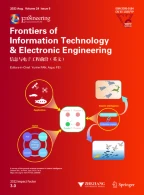Abstract
Ocular artifacts cause the main interfering signals within electroencephalogram (EEG) signal measurements. An adaptive filter based on reference signals from an electrooculogram (EOG) can reduce ocular interference, but collecting EOG signals during a long-term EEG recording is inconvenient and uncomfortable for the subject. To remove ocular artifacts from EEG in brain-computer interfaces (BCIs), a method named spatial constraint independent component analysis based recursive least squares (SCICA-RLS) is proposed. The method consists of two stages. In the first stage, independent component analysis (ICA) is used to decompose multiple EEG channels into an equal number of independent components (ICs). Ocular ICs are identified by an automatic artifact detection method based on kurtosis. Then empirical mode decomposition (EMD) is employed to remove any cerebral activity from the identified ocular ICs to obtain exact artifact ICs. In the second stage, first, SCICA applies exact artifact ICs obtained in the first stage as a constraint to extract artifact ICs from the given EEG signal. These extracted ICs are called spatial constraint ICs (SC-ICs). Then the RLS based adaptive filter uses SC-ICs as reference signals to reduce interference, which avoids the need for parallel EOG recordings. In addition, the proposed method has the ability of fast computation as it is not necessary for SCICA to identify all ICs like ICA. Based on the EEG data recorded from seven subjects, the new approach can lead to average classification accuracies of 3.3% and 12.6% higher than those of the standard ICA and raw EEG, respectively. In addition, the proposed method has 83.5% and 83.8% reduction in time-consumption compared with the standard ICA and ICA-RLS, respectively, which demonstrates a better and faster OA reduction.
Similar content being viewed by others
References
Akhtar, M.T., Mitsuhashi, W., James, C.J., 2012. Employing spatially constrained ICA and wavelet denoising, for automatic removal of artifacts from multichannel EEG data. Signal Process., 92(2):401–416. [doi:10.1016/j.sigpro.2011.08.005]
Arasteh, A., Janghorbani, A., Moradi, M.H., 2010. A survey on EMD sensitivity to SNR for EEG feature extraction in BCI application. Proc. 5th Cairo Int. Biomedical Engineering Conf., p.175–179. [doi:10.1109/CIBEC.2010.5716061]
Barbati, G., Porcaro, C., Zappasodi, P., et al., 2004. Optimization of an independent component analysis approach for artifact identification and removal in magnetoencephalographic signals. Clin. Neurophysiol., 115(5):1220–1232. [doi:10.1016/j.clinph.2003.12.015]
Blankertz, B., Dornhege, G., Krauledat, M., et al., 2007. The non-invasive Berlin brain-computer interface: fast acquisition of effective performance in untrained subjects. NeuroImage, 37(2):539–550.
Chan, H.L., Tsai, Y.T., Meng, L.F., et al., 2010. The removal of ocular artifacts from EEG signals using adaptive filters based on ocular source components. Ann. Biomed. Eng., 38(11):3489–3499. [doi:10.1007/s10439-010-0087-2]
Delorme, A., Sejnowski, T., Makeig, S., 2007. Enhanced detection of artifacts in EEG data using higher-order statistics and independent component analysis. NeuroImage, 34(4):1443–1449. [doi:10.1016/j.neuroimage.2006.11.004]
Güçlü, U., Güçlütürk, Y., Loo, C.K., 2011. Evaluation of fractal dimension estimation methods for feature extraction in motor imagery based brain computer interface. Procedia Comput. Sci., 3:589–594. [doi:10.1016/j.procs.2010.12.098]
Hazra, B., Roffel, A., Narasimhan, S., et al., 2010. Modified cross-correlation method for the blind identification of structures. J. Eng. Mech., 136(7):889–897. [doi:10.1061/(ASCE)EM.1943-7889.0000133]
He, P., Wilson, G., Russell, C., 2004. Removal of ocular artifacts from electroencephalogram by adaptive filtering. Med. Biol. Eng. Comput, 42(3):407–412. [doi:10.1007/BF02344717]
Hesse, C.W., James, C.J., 2005. The FastICA algorithm with spatial constraints. IEEE Signal Process. Lett., 12(11): 792–795. [doi:10.1109/LSP.2005.856867]
Huang, L., Wang, H., 2013. Reducing the computation time for BCI using improved ICA algorithms. Proc. 10th Int. Symp. on Neural Networks, p.299–304. [doi:10.1007/978-3-642-39068-5_37]
Jung, T.P., Makeig, S., Humphries, C., et al., 2000. Removing electroencephalographic artifacts by blind source separation. Psychophysiology, 37(2):163–178. [doi:10.1007/978-3-540-74819-9_84]
Klados, M.A., Bratsas, C., Frantzidis, C., et al., 2010. A kurtosis-based automatic system using naïve Bayesian classifier to identity ICA components contaminated by EOG or ECG artifacts. Proc. XII Mediterranean Conf. on Medical and Biological Engineering and Computing, p.49–52. [doi:10.1007/978-3-642-13039-7_13]
Li, X., Wang, W.B., 2013. Studying on denoising of chaotic signal using ICA and EMD. Proc. Int. Symp. on Geo-Informatics in Resource Management and Sustainable Ecosystem, p.564–572. [doi:10.1007/978-3-642-45025-9_55]
Li, Y., Koike, Y.H., 2012. A real-time BCI with a small number of channels based on CSP. Neur. Comput. Appl., 20(8): 1187–1192. [doi:10.1007/s00521-010-0481-6]
Mammone, N., Inuso, G., La Foresta, F., et al., 2007. Multiresolution ICA for artifact identification from electroencephalographic recordings. Proc. 11th Int. Conf. on Neural Networks, p.680–687. [doi:10.1007/978-3-540-74819-9_84]
Nguyen, H.A.T., Musson, J., Li, F., et al., 2012. EOG artifact removal using a wavelet neural network. Neurocomputing, 97:374–389. [doi:10.1016/j.neucom.2012.04.016]
Qiao, X., Li, D., Dong, Y., 2009. P300 feature extraction based on parametric model and FastICA algorithm. Proc. 5th Int. Conf. on Natural Computation, p.585–589. [doi:10.1109/ICNC.2009.160]
Wang, B., 2010. Comprehensive Study on Removal of Artifacts from EEG Data. MS Thesis, Zhejiang University, Hangzhou, China (in Chinese).
Winkler, I., Brandl, S., Horn, F., et al., 2014. Robust artifactual independent component classification for BCI practitioners. J. Neur. Eng., 11(3):035013.1–035013.10. [doi:10.1088/1741-2560/11/3/035013]
Xu, H., Song, W., Hu, Z.P., et al., 2010. A speedup SVM decision method for online EEG processing in motor imagery BCI. Proc. 10th Int. Conf. on Intelligent Systems Design and Applications, p.149–154. [doi:10.1109/ISDA. 2010.5687274]
Yang, B.H., Yan, G.Z., Wu, T., et al., 2007. Subject-based feature extraction using fuzzy wavelet packet in brain-computer interfaces. Signal Process., 87(7):1569–1574. [doi:10.1016/j.sigpro.2006.12.018]
Author information
Authors and Affiliations
Corresponding author
Additional information
Project supported by the National Natural Science Foundation of China (Nos. 31100709 and 60975079) and the Shanghai Pujiang Program, China (No. 14PJ1431300)
ORCID: Bang-hua YANG, http://orcid.org/0000-0003-4261-9875
Rights and permissions
About this article
Cite this article
Yang, Bh., He, Lf., Lin, L. et al. Fast removal of ocular artifacts from electroencephalogram signals using spatial constraint independent component analysis based recursive least squares in brain-computer interface. Frontiers Inf Technol Electronic Eng 16, 486–496 (2015). https://doi.org/10.1631/FITEE.1400299
Received:
Accepted:
Published:
Issue Date:
DOI: https://doi.org/10.1631/FITEE.1400299
Key words
- Ocular artifacts
- Electroencephalogram (EEG)
- Electrooculogram (EOG)
- Brain-computer interface (BCI)
- Spatial constraint independent component analysis based recursive least squares (SCICA-RLS)
